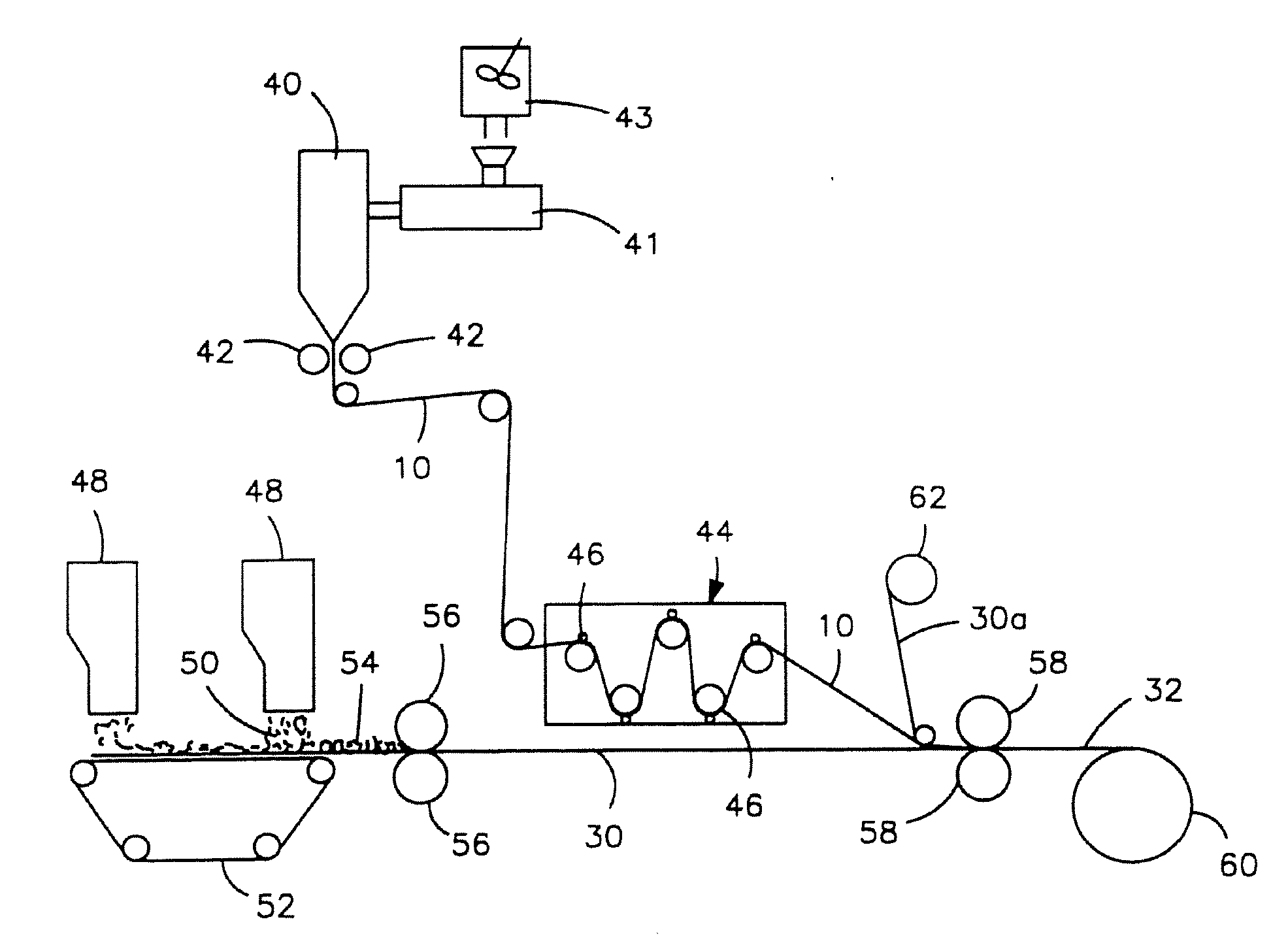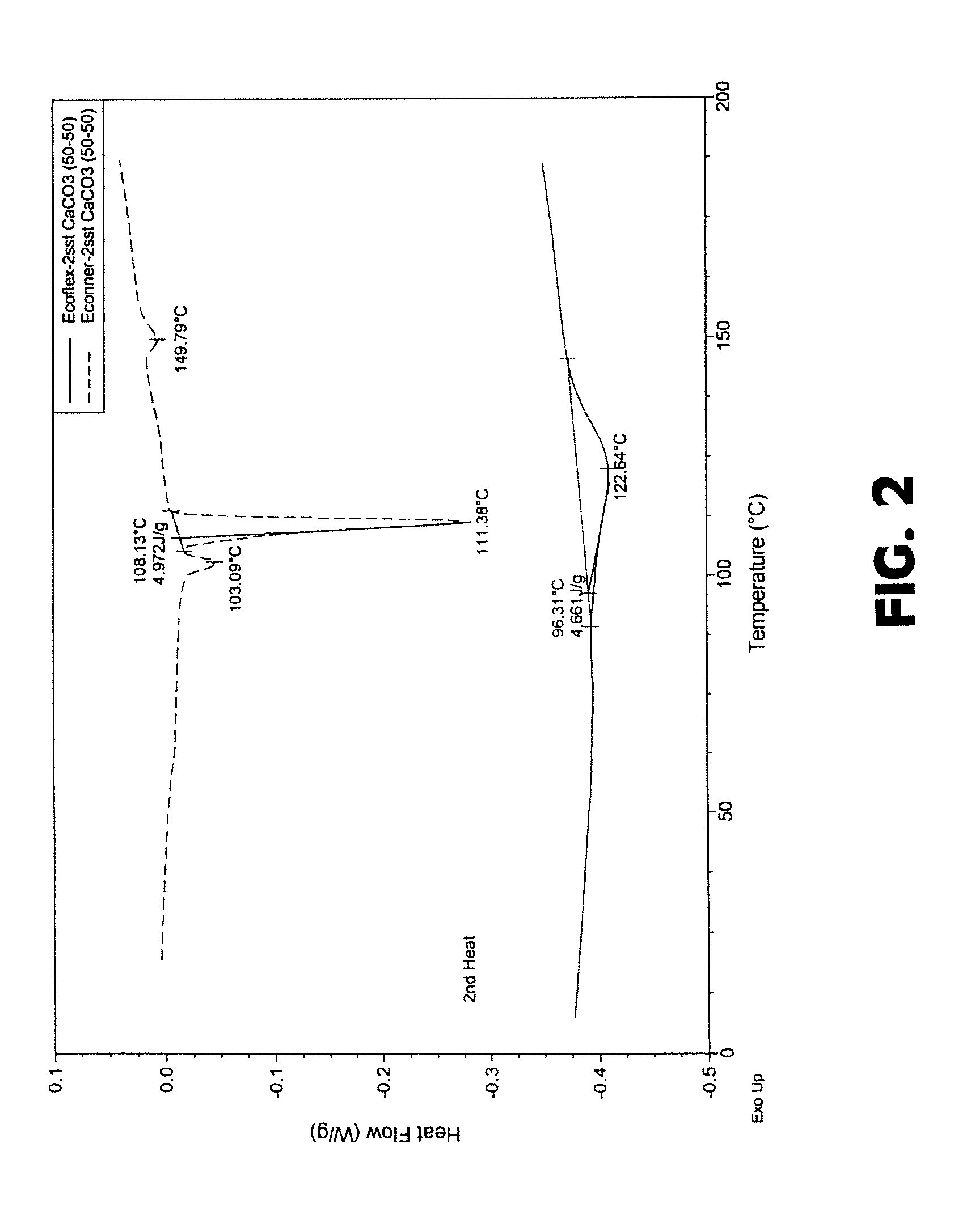Film Formed from a Blend of Biodegradable Aliphatic-Aromatic Copolyesters
a biodegradable, aromatic technology, applied in the direction of synthetic resin layered products, medical patches, textiles and paper, etc., can solve the problems of lack of the wide range of processing and physical properties often needed
- Summary
- Abstract
- Description
- Claims
- Application Information
AI Technical Summary
Problems solved by technology
Method used
Image
Examples
examples
[0072]The following test methods were employed in the examples.
Test Methods
Breathability:
[0073]The WVTR (water vapor transmission rate) value of was determined using the test procedure standardized by INDA (Association of the Nonwoven Fabrics Industry), number IST-70.4-99, entitled “STANDARD TEST METHOD FOR WATER VAPOR TRANSMISSION RATE THROUGH NONWOVEN AND PLASTIC FILM USING A GUARD FILM AND VAPOR PRESSURE SENSOR”, which is incorporated herein in its entirety by reference thereto for all purposes. The INDA test procedure is summarized as follows. A dry chamber is separated from a wet chamber of known temperature and humidity by a permanent guard film and the sample material to be tested. The purpose of the guard film is to define a definite air gap and to quiet or still the air in the air gap while the air gap is characterized. The dry chamber, guard film, and the wet chamber make up a diffusion cell in which the test film is sealed. The sample holder is known as the Permatran-W Mo...
examples 1-5
[0085]The ability to form a microporous film from an aliphatic-aromatic copolyester formed from a dimethyl isophthalate monomer was demonstrated. More specifically, the aliphatic-aromatic copolyester was obtained from Econeer, Inc. under the designation “Ecopol™ EBP 203.” Ecopol™ EBP 203 had two melting peaks of 106° C. and 112° C., and the respective enthalpies of melting were 6 and 9 J / mol.
[0086]Two types of inorganic fillers were also used, i.e., “2sst” CaCO3 (Omya, Inc. Alpharetta, Ga.), and Microtalc™ MP 3036 (Barretts Minerals, Inc. Dillon, Mont.). The mean particle size for 2sst CaCO3 was 2 microns. Microtalc™ MP 3036 had a median particle size is 3 microns and contained about 61% silicon dioxide and 31% magnesium oxide. Blends of the polymer and fillers were made using ZSK-30 extruder (Werner and Pfleiderer Corporation, Ramsey, N.J.), which is a co-rotating, twin screw extruder. The extruder diameter was 30 mm with the length of the screws up to 1328 mm. The extruder had 14 ...
examples 6-8
[0088]The ability to form a microporous film from a blend of a first aliphatic-aromatic copolyester formed from a terephthalic acid monomer and a second aliphatic-aromatic copolyester formed from a dimethyl isophthalate monomer was demonstrated. More specifically, the first copolyester was obtained from BASF under the designation “Ecoflex® F BX 7011” and the second copolyester was obtained from Econeer, Inc. under the designation “Ecopol™ EBP 203.”“2sst” CaCO3 (Omya, Inc. Alpharetta, Ga.) was employed as an inorganic filler. The melting peak of Ecoflex® F BX 7011 was 119° C. and its enthalpy of melting was 19.3 J / mol.
[0089]Blends of the polymer and filler were made using ZSK-30 extruder (Werner and Pfleiderer Corporation, Ramsey, N.J.) as described above. The Ecoflex® F BX 7011 and Ecopol™ EBP 203 resins were added to K-Tron feeder (K-Tron America, Pitman, N.J.) that vertically fed the resin into ZSK-30 extruder. Barrel #1 received the Ecopol™ EBP resin and the Ecoflex® F BX 7011 re...
PUM
| Property | Measurement | Unit |
|---|---|---|
| wt. % | aaaaa | aaaaa |
| melting point | aaaaa | aaaaa |
| melting point | aaaaa | aaaaa |
Abstract
Description
Claims
Application Information
 Login to View More
Login to View More - R&D
- Intellectual Property
- Life Sciences
- Materials
- Tech Scout
- Unparalleled Data Quality
- Higher Quality Content
- 60% Fewer Hallucinations
Browse by: Latest US Patents, China's latest patents, Technical Efficacy Thesaurus, Application Domain, Technology Topic, Popular Technical Reports.
© 2025 PatSnap. All rights reserved.Legal|Privacy policy|Modern Slavery Act Transparency Statement|Sitemap|About US| Contact US: help@patsnap.com



